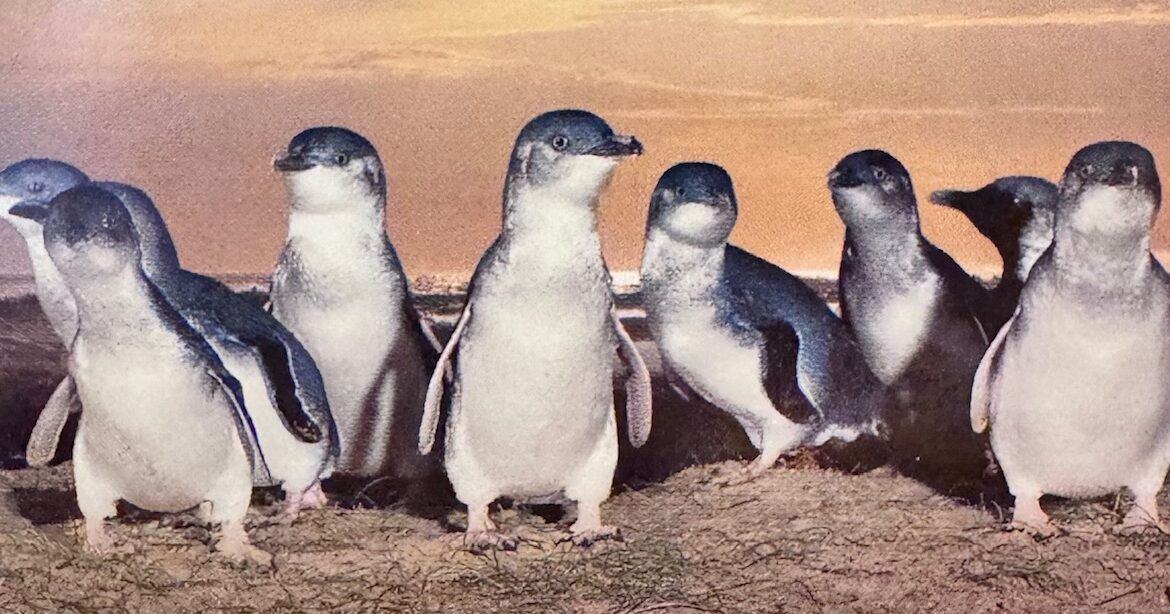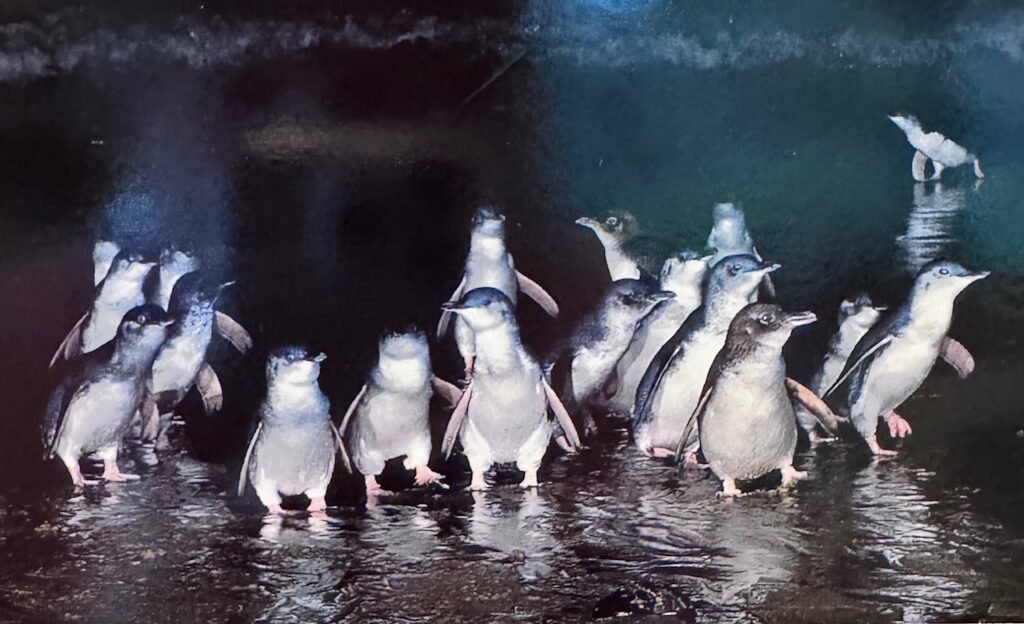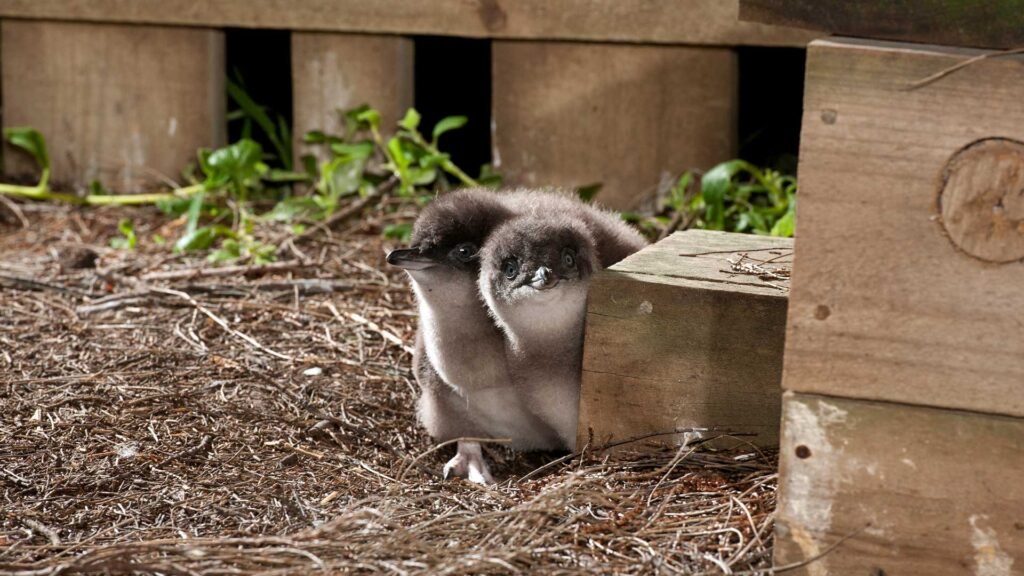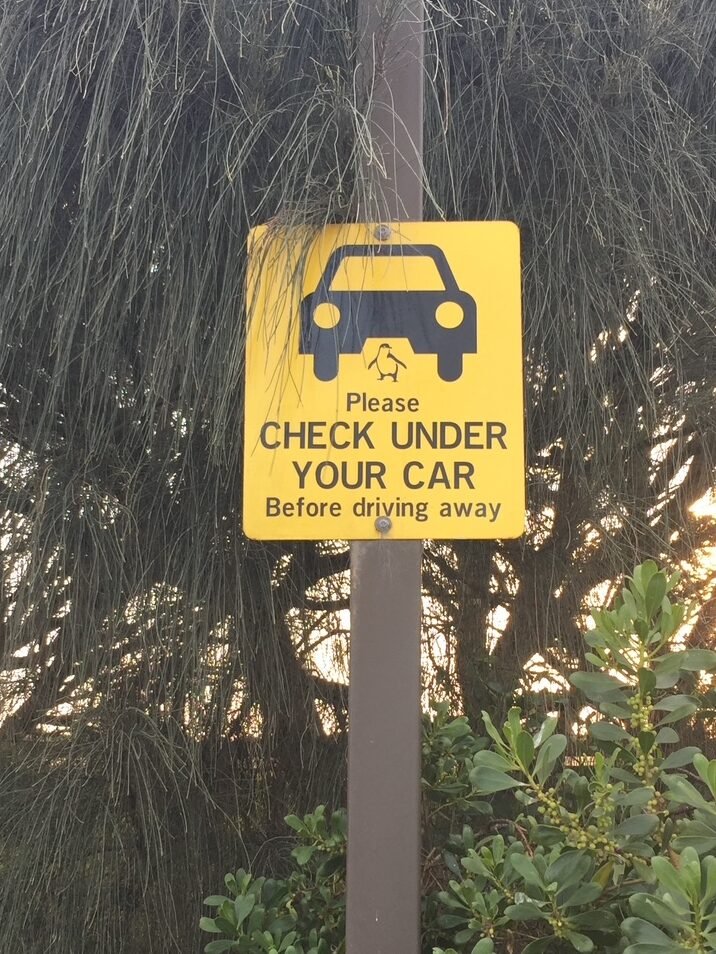Fairy Penguins
- by Jacquie Welsh
- May 6, 2025

- This better be good!
- How long ’til dusk?
- The wind is so cold.
- I can’t see through the salt spray on my glasses!
- I am freezing to death, and the signs say not to take flash pictures, even though all the tourists surrounding me are!
- Different rules for different fools
- What is it that they don’t understand about the huge sign stating, “DON’T FEED THE SEAGULLS
- OMG, my legs have gone to sleep!
- Whose crazy idea was this anyway!
- What we are doing seems incredibly lame, but 200 enthusiastic, fellow travellers cannot be wrong!
- OMG! A predator!
- It’s getting dark now, so where are they?
What’s happening, you may ask… These are just random thoughts flashing through my mind as I sit on a metal bleacher facing into a stiff, southerly gale blowing off the ocean and directly into our faces. We are anxiously awaiting the arrival of the famed Fairy Penguins. We had travelled to Phillip Island, just south of Melbourne, Australia, to see these little birds. They come out of the surf and make their way inland to their burrows, which are built into the grassy dunes behind us. Was the wait worth it – damn right it was!!!!!
On my most recent trip to Australia, one of the items on my bucket list was to see the famed Little Penguins, also known as Fairy Penguins. They are the smallest penguin species in the world and prefer rocky areas and sand rather than snow and ice. They have bright blue feathers on their backs and are just slightly bigger than a bowling pin. Over 4,000 of their total population of 32,000 live in the waters around Phillip Island in Australia. They build their burrows in the dunes at Summerland Beach, where they raise the young. It was here that we settled in to watch them come ashore at dusk.
These penguins leave their land burrows before sunrise and spend their days fishing at sea. They return to their burrows once the sun has set, when they tend to their nests and feed their young at certain times of the year. They can travel up to 20 km in the waters surrounding Phillip Island in search of food. Their return from the sea in the evening is famously known as the “Penguin Parade.”
Arriving at the venue, I parked our car and paid our admission fee to the park. My travelling companion and I then spent the requisite time in the gift shop buying souvenirs that would remind us of this, another great adventure in Australia. I am reminded of this phenomenon every Christmas as I hang my little penguin decoration on my tree.
Once we had finished shopping, we followed a boardwalk down to the beach, where metal bleachers faced the southern ocean. We had arrived early to get a good seat, so we settled in to wait. The bleachers filled up with more tourists as the daylight slowly gave way to dusk.
There was a small gale blowing inland off the southern ocean, and it was cold! I’m not exaggerating when I say that after about fifteen minutes, I had to take off my glasses and put them away in my pocket, as they were coated with a fine layer of salt. Signs were posted in several places asking people not to use the flash feature on their cameras. This did not hamper the many people surrounding us who were busy filling their camera disks with pictures, all using the flash feature on their cameras. Luckily, it was still early, and the penguins hadn’t arrived yet. I don’t know what they were taking pictures of, but everyone was having a great time.
In addition to signs asking people not to take flash pictures, there were even larger signs asking them not to feed the gulls. Many blithely ignored these signs as the gulls swept in over our heads, competing for fries and various other types of food. This phenomenon of total disregard for rules and regulations never ceases to annoy and amaze me. I often question, “What is it that they don’t understand?”
The sun had set, and dusk descended on the shoreline ahead. Suddenly, everyone in the stands quieted. As it got darker, special floodlights in a light spectrum that could not be discerned by the penguins, or the predators lying in wait for them, turned on. The lights lit the beach from the water’s edge to the area behind the stands where the penguin burrows had been built. The lights cast the beach in a strange burnt sienna glow. This lighting was designed to help everyone in the stands see the penguins marching up the dark sand.
I trained my eyes on that point where the edge of the surf rolled up onto the sandy beach, trying hard to spot the arrival of the first penguins. Suddenly, the first group appeared, rising out of the water and making their way up onto the sand. There were twelve to fifteen penguins in this first group, and once my eyes had adjusted to the dark, I was suddenly able to recognize what I was looking for. It became easier to spot these little creatures as they appeared at the waterline. The journey inland was a perilous trip as skuas, predatory gulls, circled overhead looking for their dinner.

When the first Skua appeared, everyone in the stands gasped, and someone cried out, “Oh no, a predator!” The brochure we were given described these birds as the main predators of the little penguins on their perilous journey from the sea to the safety of their burrows.
Foxes, feral cats, artificial lights and ocean pollution also pose a significant threat to the survival of these little penguins in their natural habitat. The penguins, top predators at sea, become vulnerable and threatened on their journey to their burrows. The naturalists in the many coastal conservation areas work to ensure the safety of the penguins by trapping and removing predators that threaten the population.
As more penguins emerged from the ocean, making their way up the beach, I noticed they were often quite adept at avoiding the swooping gulls. They appeared to have developed an intricate dance to confuse them. They would quickly change the direction of their movement from a forward motion to quick moves left or right, sometimes even coming to an abrupt stop before resuming a forward motion. Occasionally, they even returned to the waves to wait and try again. All this looked like a choreographed dance, provided for our entertainment as each group emerged from the ocean.
I’m sure one or two of the penguins may have been injured or killed in the attack, but I didn’t notice. I did, however, observe one little penguin being knocked over. It lay very still and flattened itself on the sand until the skua, to avoid crashing into the sand, had to rise back up into the air and prepare for landing next to the downed penguin. When it landed, the Skua discovered that the penguin had quickly righted itself and was no longer where it thought it would find its prey.
After spotting the first group on the beach, more and more of these delightful little creatures appeared in small groups at the surf line, and the beach was soon full of marching penguins. This continued well after the sun had set and darkness had enveloped the beach, lit only by the special lights.

The path of the penguins went past the bleachers where we sat, and we watched them disappear into the dunes to the safety of their burrows. We waited until the number of penguins coming out of the sea had slowed considerably. Only then did we leave the bleachers and walk along the boardwalk, where we were able to observe the little penguins standing outside their burrows or the man-made nesting boxes. There were several nests that still had little heads of their young peeking out, demanding to be fed.

We slowly made our way along the boardwalk back to the car, and, as the signs in the parking lot requested, carefully inspected the ground under it. I certainly would not want to be responsible for the death of one of these delightful creatures who might have wandered away from their nests and ended up hiding under my car.




